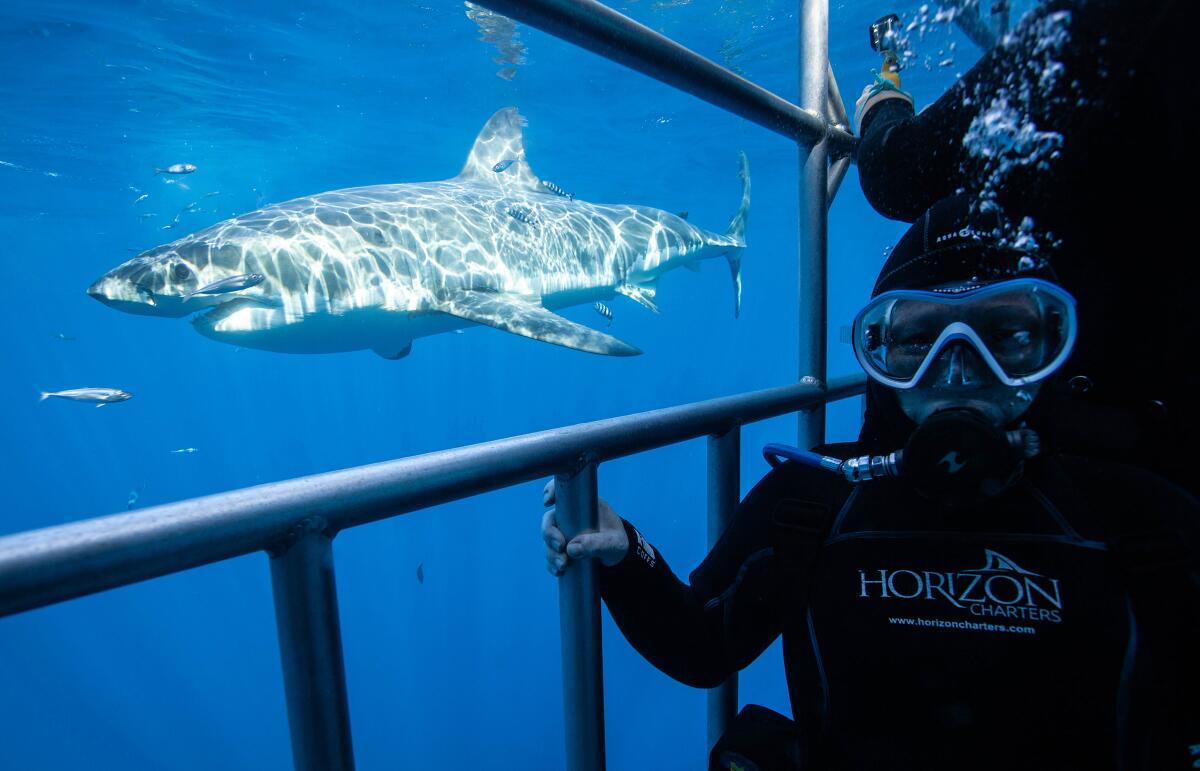San Diego shark tourism companies beached as Mexico bans cage diving

- Share via
Good morning, and welcome to the Essential California newsletter. It’s Monday, Feb. 6.
For tourists, researchers and film crews alike, the best places to see great white sharks are Australia, South Africa and Guadalupe Island, off the coast of Baja California in Mexico.
For years, the volcanic island has been a draw for the big fish and the humans who want to see them up close. But now a major part of the shark tourism industry is dead in the water.
Last month, the Mexican government banned cage diving at Guadalupe Island, citing “bad practices” among tour companies, such as divers swimming outside of cages, improper use of bait and dumping of pollutants.
Some of the affected companies are based out of San Diego and helped pioneer the cage-diving industry.
San Diego Union-Tribune reporter Joshua Emerson Smith writes:
While the country could still reverse course, the moment feels like the end of an era — one marked by revelry, scientific discoveries, injured animals and television stunts gone awry.
Like many other encounters where humans insert themselves into wild animals’ habitats, things can go wrong — and have.
Videos show sharks stuck between cage bars and even getting into cages, thrashing about as divers cower. In one video, a shark sinks motionless to the depths after injuring itself on a cage and bleeding profusely.
While the practice is controversial, Smith writes, it’s “also a celebration of a once-imperiled species.”
Many scientists feared that great whites would go extinct, but conservation laws passed in recent decades have made a difference. Based on some estimates, there are as many as 4,000 great white sharks in the Pacific between Mexico and Alaska.
Charter boats from San Diego and around the globe have ferried scientific researchers — trips some credit as crucial to understanding great whites’ migratory and feeding behavior.
With the cage-carrying charter boats beached, conservation advocates worry that the door will open to poachers.
“A single set of white shark jaws goes for about $5,000. White shark fins can go for up to $10,000,” one longtime tour guide told Smith. “It was the fact that we were there for most of the season that protected these animals.”
You can read more of Joshua Emerson Smith’s reporting in his subscriber exclusive for the San Diego Union-Tribune.
And now, here’s what’s happening across California.
Note: Some of the sites we link to may limit the number of stories you can access without subscribing.
L.A. STORIES
Thousands of people came out to pay tribute to the “king of Griffith Park” —mountain lion P-22. The big cat was euthanized in December due to numerous injuries and ailments.
“P-22’s legacy will live on in his contributions to wildlife conservation and our heightened awareness of how to live in harmony with nature,” said Jeff Sikich, a biologist with the National Park Service. Los Angeles Times

Thousands of L.A. city employees who filed religious or medical exemptions to the city’s COVID-19 vaccination requirement are set to have those requests granted. L.A.’s police and fire departments saw some of the most vocal protests over the mandate, passed in 2021. Despite the pending mass approvals, the requirement is still in effect, Mayor Karen Bass wrote in a memo. Los Angeles Times
Check out "The Times" podcast for essential news and more
These days, waking up to current events can be, well, daunting. If you’re seeking a more balanced news diet, “The Times” podcast is for you. Gustavo Arellano, along with a diverse set of reporters from the award-winning L.A. Times newsroom, delivers the most interesting stories from the Los Angeles Times every Monday, Wednesday and Friday. Listen and subscribe wherever you get your podcasts.
POLITICS AND GOVERNMENT
A federal judge will allow Oakland to begin evicting people from a long-running homeless encampment. Residents at the Wood Street Commons vowed to keep fighting. The settlement is home to roughly 60 people. KQED
California lawmakers are again trying to cap insulin costs. Senate Bill 90 by Sen. Scott Wiener (D-San Francisco) would stop state-regulated health insurance plans from imposing a deductible on prescriptions and cap the copay at $35 for a 30-day supply. The state also has an ambitious plan to manufacture its own low-cost insulin, but that’s expected to take two or three years. CalMatters
CRIME, COURTS AND POLICING
Authorities have arrested two men suspected of killing six people last month at a home in the Central Valley farm town of Goshen. Among those killed were a teen and her infant son. Both suspects are Norteño gang members, according to the Tulare County Sheriff’s Office, and one arrest came after a gun battle with federal agents. Los Angeles Times
An LAPD SWAT officer received a two-day suspension roughly nine months after he was caught on body-camera video wishing his colleagues “happy hunting” before a fatal police shooting. Department critics say the incident reflects a culture of brutality within SWAT. Los Angeles Times
A community is stunned after the violent murder of an Orange County doctor last week. Dr. Michael John Mammone was riding his bike in Dana Point when a motorist struck him from behind, then got out of the vehicle and repeatedly stabbed him, police said. That motorist, identified as Vanroy Evan Smith, faces charges for murder. Los Angeles Times
Support our journalism
HEALTH AND THE ENVIRONMENT
Many of California’s farmworkers face chronic illness, according to a new study, and many struggle to access reliable healthcare. Researchers from UC Merced found that between one-third and half of workers surveyed reported having at least one chronic condition. Nearly half reported being without health insurance. The Fresno Bee

A California law banning new oil and gas wells near homes, schools and other community sites took effect at the start of this year but is now on hold. Oil and gas industry officials who oppose the law gathered enough petition signatures to put a referendum on the 2024 ballot. Associated Press
While COVID raged, another deadly threat surged in California hospitals. State data showed an uptick in people being treated for severe sepsis in recent years — including cases contracted within hospitals. Los Angeles Times
The Sierra Nevada snowpack may be the deepest it’s been in decades, but it won’t help refill dramatically depleted reservoirs. The Colorado River crisis is so severe that some climate scientists predict lakes Mead and Powell are unlikely to refill in our lifetimes. Los Angeles Times
CALIFORNIA CULTURE
The recent mass shootings in Half Moon Bay put a spotlight on mushroom farming. Here’s a look at how the fungi are grown and harvested. San Francisco Chronicle
Media-analyst-turned-media-owner Ken Doctor founded Lookout Santa Cruz in 2020, aiming to address a “worsening news desert.” His digital startup model is challenging local rivals at the north end of Monterey Bay. Los Angeles Times
Free online games
Get our free daily crossword puzzle, sudoku, word search and arcade games in our new game center at latimes.com/games.
AND FINALLY
Today’s landmark love comes from Kirk Vogt of Roseville: Trinity River valley in Trinity County.
Kirk writes:
After spending a Thanksgiving in Junction City, my drive back to Sacramento was interrupted by this incredible view. The previous day’s snow had dusted the coastal mountains, the Trinity River at the base of the mountain was covered in fog, and a ring of low-lying clouds showcased this coastal mountain region of Northern California. No other part of California has such fresh air and a clear view of a river valley. No wonder this setting was a perfect location for the 1938 film “Gold Is Where You Find It.”
What are California’s essential landmarks? Fill out this form to send us your photos of a special spot in California — natural or human-made. Tell us why it’s interesting and what makes it a symbol of life in the Golden State. Please be sure to include only photos taken directly by you. Your submission could be featured in a future edition of the newsletter.
Please let us know what we can do to make this newsletter more useful to you. Send comments to essentialcalifornia@latimes.com.
Sign up for Essential California
The most important California stories and recommendations in your inbox every morning.
You may occasionally receive promotional content from the Los Angeles Times.




